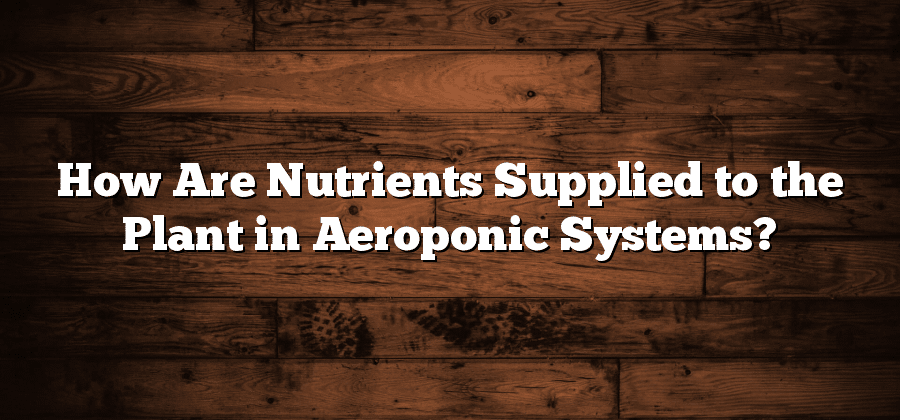Overview of Aeroponic Systems
Aeroponic systems have gained popularity in recent years as an innovative method of plant cultivation. Unlike traditional soil-based systems, aeroponics involves growing plants in an air or mist environment, where their roots are suspended in air and periodically misted with a nutrient-rich solution. This unique approach allows for increased oxygenation and nutrient delivery directly to the roots, resulting in faster growth rates and higher yields.
One of the primary advantages of aeroponic systems is the ability to control and optimize nutrient delivery. By misting the roots with a nutrient solution, plants can readily absorb the necessary elements for growth. This precision in nutrient delivery allows for a more efficient use of resources and reduces the risk of over or under fertilization. Additionally, aeroponic systems require significantly less water compared to traditional soil-based systems, making them an environmentally-friendly choice for plant cultivation.
The Role of Nutrients in Plant Growth
Plants, like all living organisms, require essential nutrients in order to grow and thrive. These nutrients play a crucial role in various physiological processes, such as photosynthesis, respiration, cell division, and overall plant development. Without an adequate supply of nutrients, plants can experience stunted growth, yellowing of leaves, and reduced yield.
The role of nutrients in plant growth extends beyond their basic function of providing essential elements. They also contribute to the overall health and resilience of the plant. For instance, certain nutrients, such as nitrogen, phosphorus, and potassium, are known as macronutrients. These macronutrients are required in larger quantities and are involved in the synthesis of proteins and enzymes, energy transfer, and cell division. On the other hand, micronutrients like iron, zinc, and manganese are needed in smaller amounts, but are equally vital for various physiological processes. Deficiencies or imbalances in these essential nutrients can have a detrimental impact on plant growth and development.
Understanding Nutrient Absorption in Aeroponic Systems
Nutrient absorption is a crucial process in aeroponic systems that directly impacts plant growth and overall system efficiency. In this innovative method of plant cultivation, nutrients are supplied directly to the roots as a mist, allowing for maximum absorption and utilization by the plants. Unlike traditional soil-based systems, where plants extract nutrients from the soil, aeroponic systems rely on nutrient solutions that are carefully formulated to provide all the necessary elements in the right proportions.
The absorption of nutrients in aeroponic systems is primarily achieved through the root hairs, which are tiny extensions of the root system responsible for nutrient uptake. These root hairs have a large surface area, which allows for efficient nutrient absorption. As the nutrient solution is sprayed onto the roots, the root hairs come into contact with the mist, absorbing the necessary elements to support plant growth. As a result, plants in aeroponic systems can quickly and effectively access the nutrients they need, leading to faster growth rates and healthier, more robust plants.
The Importance of pH in Nutrient Uptake
Plants require certain levels of pH in their environment to efficiently uptake nutrients and thrive. The pH level of a nutrient solution plays a crucial role in the availability and absorption of different nutrients by the plant’s roots. Maintaining the correct pH balance is essential for the optimal growth and development of plants in aeroponic systems.
A pH level that is too high or too low can negatively impact nutrient availability and uptake. When the pH is too high (alkaline), certain essential nutrients, such as iron, manganese, and zinc, become less soluble and are not readily absorbed by the plant. Conversely, if the pH is too low (acidic), other nutrients like phosphorus, calcium, and magnesium may become less available, limiting the plant’s ability to absorb them effectively. Therefore, closely monitoring and adjusting the pH of the nutrient solution is vital to ensure plants can access and uptake the necessary nutrients for healthy growth.
Types of Nutrient Solutions Used in Aeroponics
In aeroponics, the nutrient solution plays a crucial role in providing plants with the essential elements they need for growth. These nutrient solutions are specifically formulated to meet the unique requirements of plants grown in aeroponic systems. Unlike traditional growing methods, where plants obtain nutrients from the soil, aeroponics relies on a carefully balanced nutrient solution to support plant health and development.
There are several types of nutrient solutions used in aeroponics, each tailored to meet the specific needs of different plants. Some solutions are designed for general use and can be suitable for a wide range of plants. These solutions typically contain a balanced combination of essential nutrients, including nitrogen, phosphorus, and potassium, along with trace elements like iron, manganese, and zinc. Other nutrient solutions are formulated to address the specific nutritional requirements of certain plant varieties, such as leafy greens or fruiting crops. These specialized solutions often contain higher concentrations of certain nutrients that are critical for optimal growth and yield.






